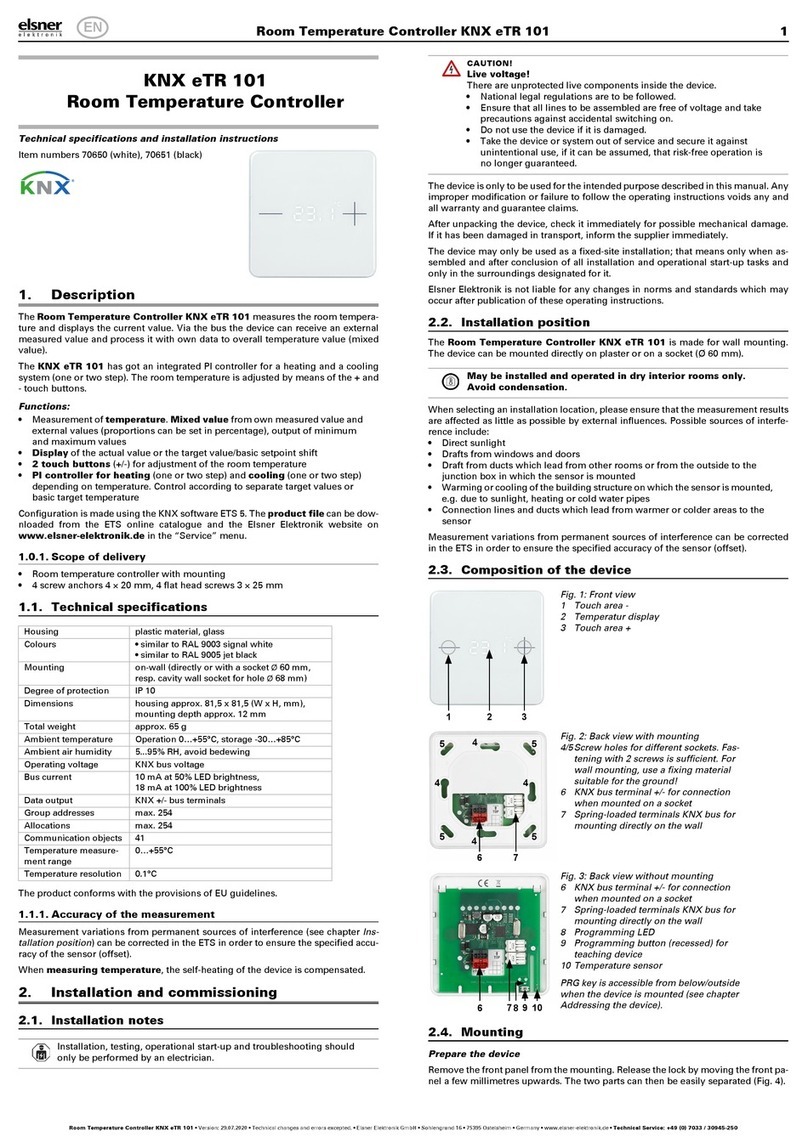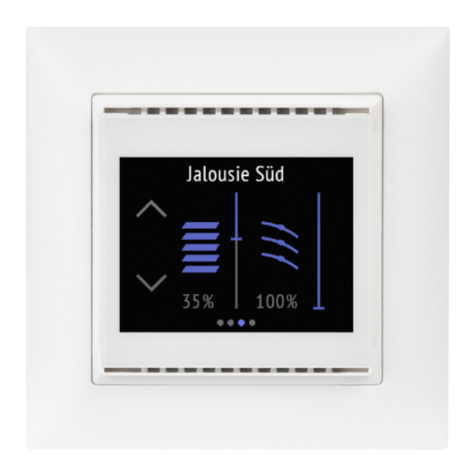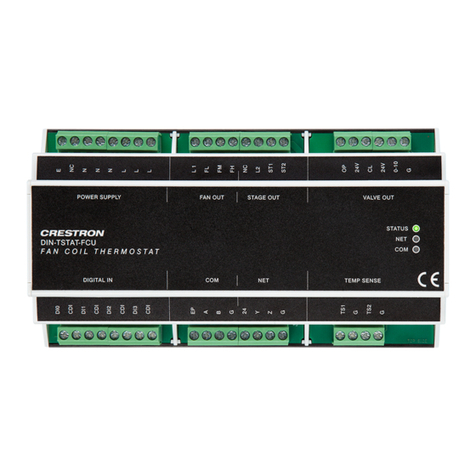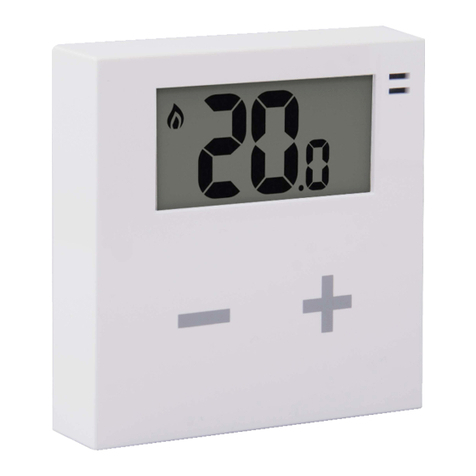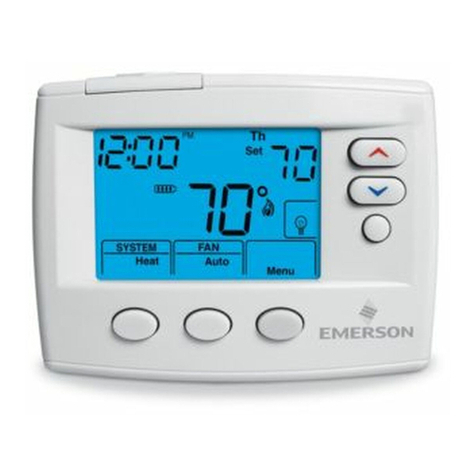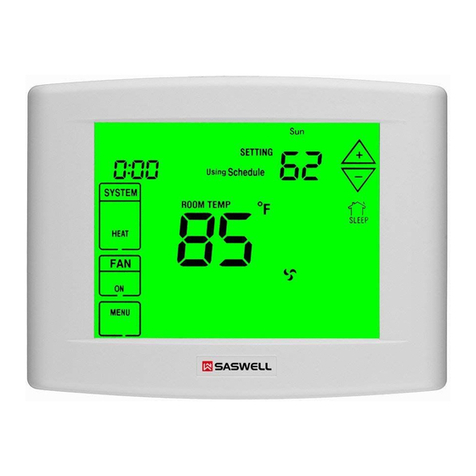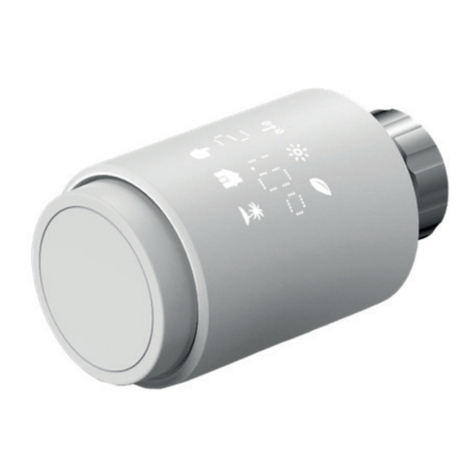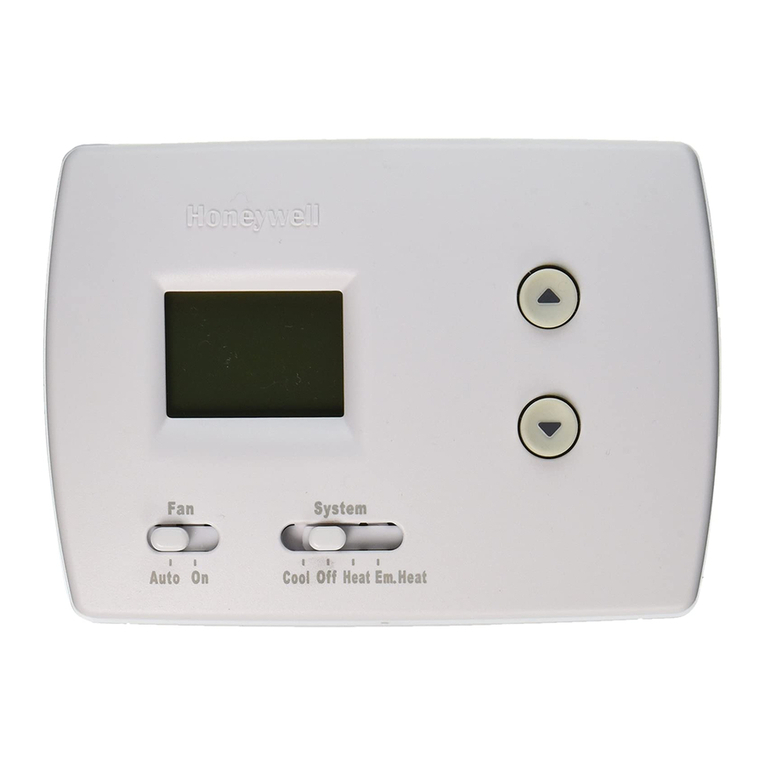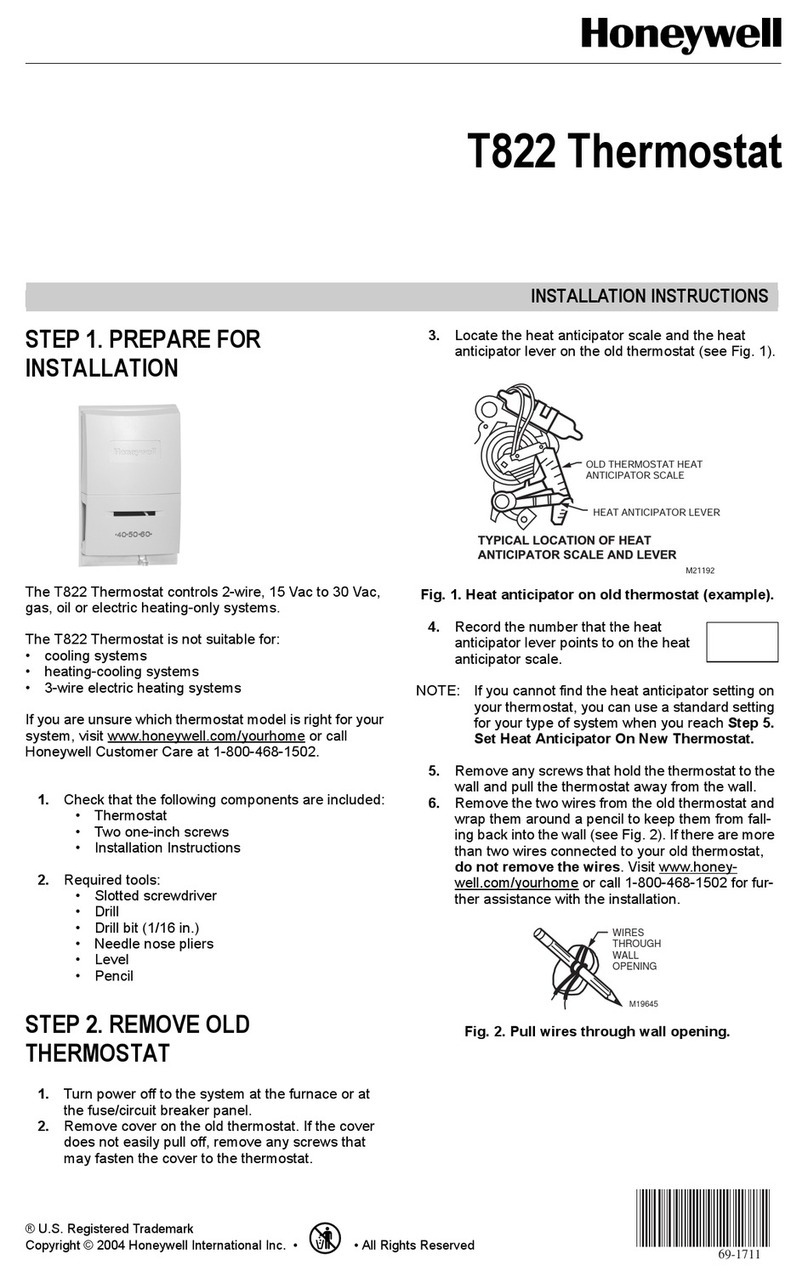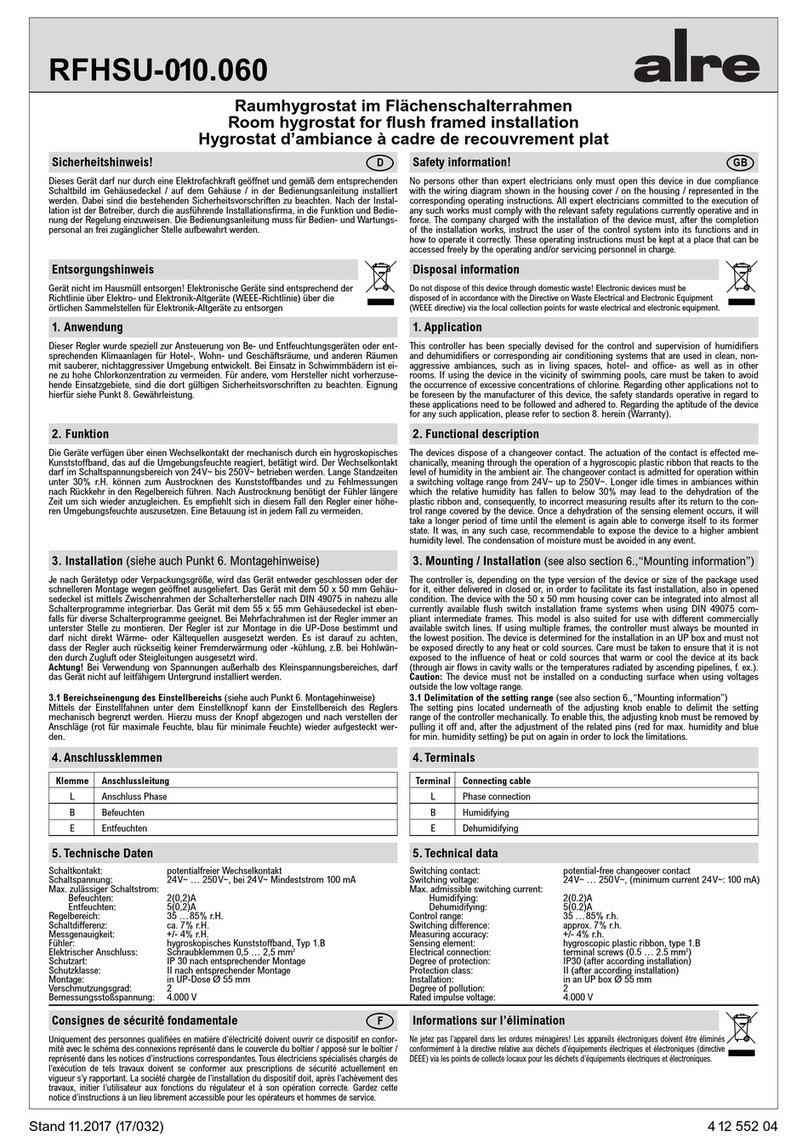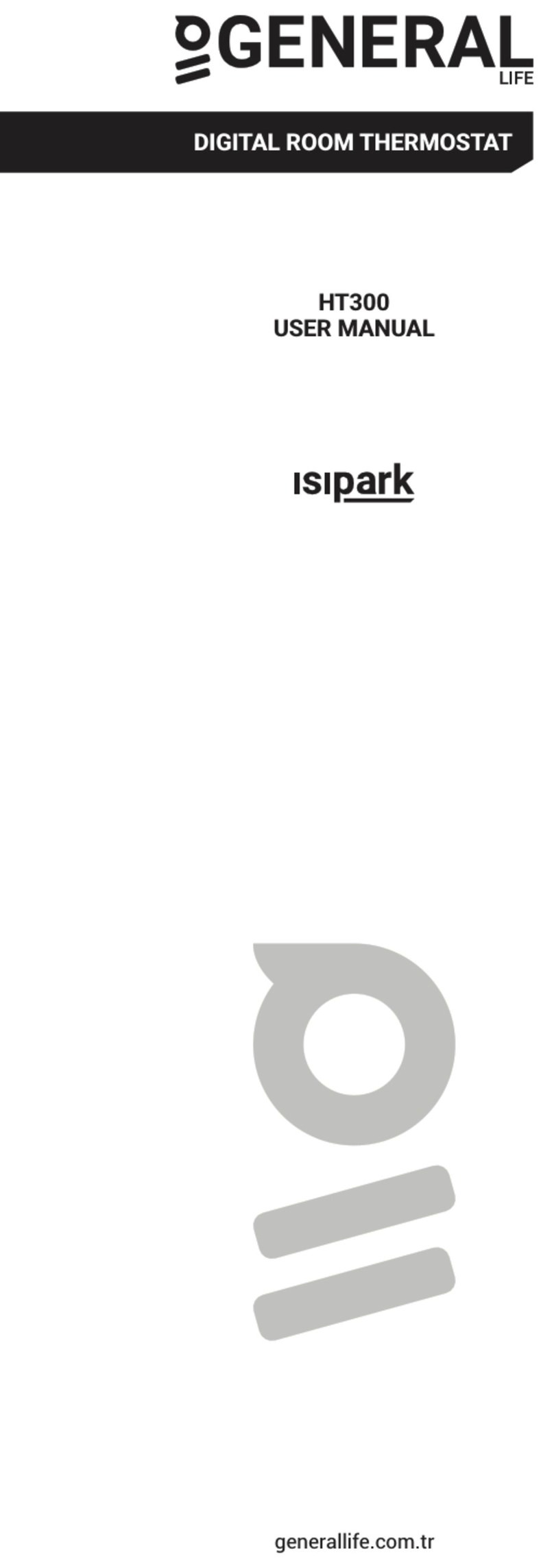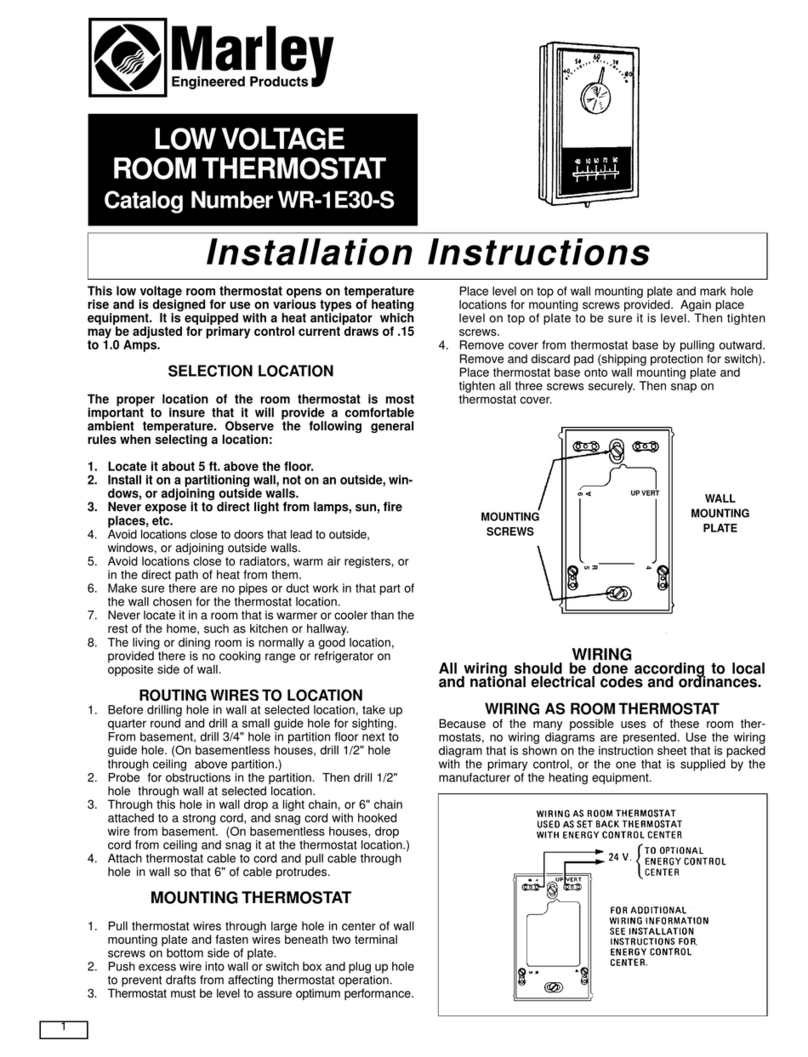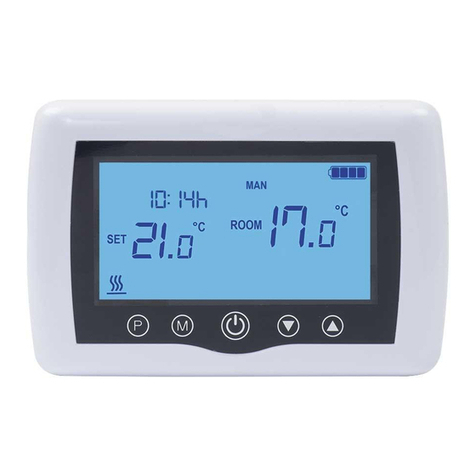Elsner KNX eTR 101 Guide

KNX eTR 101
Room Temperature Controller
Item numbers 70650 (white), 70651 (black)
EN
Installation and Adjustment


1 Content
Elsner Elektronik GmbH • Sohlengrund 16 • 75395 Ostelsheim • Germany
Room Temperature Controller KNX eTR 101 • from KNX application 2.0, device software version 0.2.0
Status: 29.07.2020 • Technical changes and errors excepted.
1. Description ........................................................................................... 3
1.0.1. Scope of delivery .......................................................................................... 3
1.1. Technical specifications ........................................................................................... 3
1.1.1. Accuracy of the measurement ..................................................................... 4
2. Installation and commissioning ........................................................... 4
2.1. Installation notes ...................................................................................................... 4
2.2. Installation position .................................................................................................. 5
2.3. Composition of the device ....................................................................................... 5
2.4. Mounting ................................................................................................................... 6
2.5. Notes on mounting and commissioning ................................................................ 8
3. Addressing the device .......................................................................... 8
4. Display and operation at the device .................................................... 8
4.1. Adjust room temperature ........................................................................................ 8
5. Maintenance and care ........................................................................ 10
6. Disposal ............................................................................................. 10
7. Transfer protocol ............................................................................... 11
7.1. List of all communication objects ......................................................................... 11
8. Setting the parameters ...................................................................... 13
8.1. Behaviour on power failure/ restoration of power .............................................. 13
8.2. General settings ..................................................................................................... 13
8.3. Temperature measured value ............................................................................... 14
8.4. Temperature PI controller ...................................................................................... 14
8.4.1. Heating control stage 1/2 ........................................................................... 20
8.4.2. Cooling control stage 1/2 ........................................................................... 22

2 Clarification of signs
This manual is amended periodically and will be brought into line with new software
releases. The change status (software version and date) can be found in the contents footer.
If you have a device with a later software version, please check
www.elsner-elektronik.de in the menu area "Service" to find out whether a more up-to-
date version of the manual is available.
Clarification of signs used in this manual
Installation, inspection, commissioning and troubleshooting of the device
must only be carried out by a competent electrician.
Safety advice.
Safety advice for working on electrical connections, components,
etc.
DANGER! ... indicates an immediately hazardous situation which will lead to
death or severe injuries if it is not avoided.
WARNING! ... indicates a potentially hazardous situation which may lead to
death or severe injuries if it is not avoided.
CAUTION! ... indicates a potentially hazardous situation which may lead to
trivial or minor injuries if it is not avoided.
ATTENTION! ... indicates a situation which may lead to damage to property if it is
not avoided.
ETS In the ETS tables, the parameter default settings are marked by
underlining.

3 Description
Room Temperature Controller KNX eTR 101 • Version: 29.07.2020 • Technical changes and errors excepted.
1. Description
The Room Temperature Controller KNX eTR 101 measures the room temperature
and displays the current value. Via the bus the device can receive an external measured
value and process it with own data to overall temperature value (mixed value).
The KNX eTR 101 has got an integrated PI controller for a heating and a cooling
system (one or two step). The room temperature is adjusted by means of the + and -
touch buttons.
Functions:
• Measurement of temperature. Mixed value from own measured value and
external values (proportions can be set in percentage), output of minimum and
maximum values
•Display of the actual value or the target value/basic setpoint shift
•2 touch buttons (+/-) for adjustment of the room temperature
•PI controller for heating (one or two step) and cooling (one or two step)
depending on temperature. Control according to separate target values or
basic target temperature
Configuration is made using the KNX software ETS 5. The product file can be
downloaded from the ETS online catalogue and the Elsner Elektronik website on
www.elsner-elektronik.de in the “Service” menu.
1.0.1. Scope of delivery
• Room temperature controller with mounting
• 4 screw anchors 4 × 20 mm, 4 flat head screws 3 × 25 mm
1.1. Technical specifications
Housing plastic material, glass
Colours • similar to RAL 9003 signal white
• similar to RAL 9005 jet black
Mounting on-wall (directly or with a socket Ø60 mm, resp. cavity
wall socket for hole Ø68 mm)
Degree of protection IP 10
Dimensions housing approx. 81,5 x 81,5 (W x H, mm),
mounting depth approx. 12 mm
Total weight approx. 65 g
Ambient temperature Operation 0…+55°C, storage -30…+85°C
Ambient air humidity 5...95% RH, avoid bedewing
Operating voltage KNX bus voltage
Bus current 10 mA at 50% LED brightness,
18 mA at 100% LED brightness
Data output KNX +/- bus terminals
Group addresses max. 254

4 Installation and commissioning
Room Temperature Controller KNX eTR 101 • Version: 29.07.2020 • Technical changes and errors excepted.
The product conforms with the provisions of EU guidelines.
1.1.1. Accuracy of the measurement
Measurement variations from permanent sources of interference (see chapter
Installation position) can be corrected in the ETS in order to ensure the specified
accuracy of the sensor (offset).
When measuring temperature, the self-heating of the device is compensated.
2. Installation and commissioning
2.1. Installation notes
Installation, testing, operational start-up and troubleshooting should
only be performed by an electrician.
CAUTION!
Live voltage!
There are unprotected live components inside the device.
• National legal regulations are to be followed.
• Ensure that all lines to be assembled are free of voltage and take
precautions against accidental switching on.
• Do not use the device if it is damaged.
• Take the device or system out of service and secure it against
unintentional use, if it can be assumed, that risk-free operation is
no longer guaranteed.
The device is only to be used for the intended purpose described in this manual. Any
improper modification or failure to follow the operating instructions voids any and all
warranty and guarantee claims.
After unpacking the device, check it immediately for possible mechanical damage. If it
has been damaged in transport, inform the supplier immediately.
The device may only be used as a fixed-site installation; that means only when
assembled and after conclusion of all installation and operational start-up tasks and
only in the surroundings designated for it.
Elsner Elektronik is not liable for any changes in norms and standards which may occur
after publication of these operating instructions.
Allocations max. 254
Communication objects 41
Temperature measurement
range
0…+55°C
Temperature resolution 0.1°C

5 Installation and commissioning
Room Temperature Controller KNX eTR 101 • Version: 29.07.2020 • Technical changes and errors excepted.
2.2. Installation position
The Room Temperature Controller KNX eTR 101 is made for wall mounting. The
device can be mounted directly on plaster or on a socket (Ø 60 mm).
May be installed and operated in dry interior rooms only.
Avoid condensation.
When selecting an installation location, please ensure that the measurement results
are affected as little as possible by external influences. Possible sources of interference
include:
• Direct sunlight
• Drafts from windows and doors
• Draft from ducts which lead from other rooms or from the outside to the
junction box in which the sensor is mounted
• Warming or cooling of the building structure on which the sensor is mounted,
e.g. due to sunlight, heating or cold water pipes
• Connection lines and ducts which lead from warmer or colder areas to the
sensor
Measurement variations from permanent sources of interference can be corrected in
the ETS in order to ensure the specified accuracy of the sensor (offset).
2.3. Composition of the device
13
Fig. 1: Front view
1 Touch area -
2 Temperatur display
3 Touch area +
2

6 Installation and commissioning
Room Temperature Controller KNX eTR 101 • Version: 29.07.2020 • Technical changes and errors excepted.
2.4. Mounting
Prepare the device
Remove the front panel from the mounting. Release the lock by moving the front panel
a few millimetres upwards. The two parts can then be easily separated (Fig. 4).
4
5
6
Fig. 2: Back view with mounting
4/5 Screw holes for different sockets. Fastening
with 2 screws is sufficient. For wall mounting,
use a fixing material suitable for the ground!
6 KNX bus terminal +/- for connection when
mounted on a socket
7 Spring-loaded terminals KNX bus for moun-
ting directly on the wall
4
44
55
5
7
Fig. 3: Back view without mounting
6 KNX bus terminal +/- for connection when
mounted on a socket
7 Spring-loaded terminals KNX bus for moun-
ting directly on the wall
8 Programming LED
9 Programming button (recessed) for teaching
device
10 Temperature sensor
PRG key is accessible from below/outside when
the device is mounted (see chapter Addressing
the device).
679108

7 Installation and commissioning
Room Temperature Controller KNX eTR 101 • Version: 29.07.2020 • Technical changes and errors excepted.
Screw the mounting onto the wall or socket. The connecting wires (bus line +/-) are led
through the opening in the mounting.
Installation directly on the wall
The wires are pushed into the connection openings.
Installation on a socket
To avoid falsifying the temperature value, use a wind-proof socket and also seal the in-
let pipes against draughts.
Finish mounting
Snap the front panel into place on the mounting (see Fig. 4): Place it slightly above the
centre position, hook it in and slide it downwards.
Fig. 4 Locking of front panel and mounting
Remove the red-black KNX bus terminal, it is not
required.
Connect the bus +/- connecting wires to the spring-
loaded terminals on the front panel.
Fig. 5 Spring-loaded terminals
To pull it out, press the spring down, e.g. with a
screwdriver.
If there is a cavity behind the device, e.g. when
using a socket, you can use the red/black KNX bus
terminal for connection.

8 Addressing the device
Room Temperature Controller KNX eTR 101 • Version: 29.07.2020 • Technical changes and errors excepted.
2.5. Notes on mounting and commissioning
Never expose the device to water (e.g. rain) or dust. This can damage the electronics.
You must not exceed a relative humidity of 95%. Avoid condensation.
After the bus voltage has been applied, the device will enter an initialisation phase
lasting a few seconds. During this phase no information can be received or sent via the
bus.
3. Addressing the device
The device is delivered ex works with the bus address 15.15.255. You program a differ-
ent address in the ETS by overwriting the address 15.15.255 or teach the device using
the programming button.
The programming button is located at the bottom outer side of the front panel of the
device and is recessed. Use a thin object to reach the button, e. g. a 1.5 mm² wire.
4. Display and operation at the device
4.1. Adjust room temperature
Depending on the setting of the "Display mode" parameter in the device application,
the Room Temperature Controller KNX eTR 101 displays the current room
temperature value (or mixed value), the target value or the shift in relation to the basic
setpoint. The display can be dimmed and switched off via the bus so that no value is
displayed.
Option A: Display of actual temperature (room temperature)
The current room temperature is displayed. It is not possible to change the room
temperature manually using the +/- buttons.
Option B: Display of target temperature or basic setpoint shift
Depending on the setting, the current target value or the shift relative to the base
setpoint is displayed. The temperature can be changed by touching the +/- buttons.
PRG
Fig. 6
View from bottom
Temperature sensor

9 Display and operation at the device
Room Temperature Controller KNX eTR 101 • Version: 29.07.2020 • Technical changes and errors excepted.
Target value display (absolute value):
Display of the basic setpoint shift (change compared to the basic setpoint of the
control):
Option C: Display of actual temperature and target temperature/basic
setpoint shift
During normal operation, the current room temperature is displayed. By touching the
buttons, the display jumps to the target temperature or to the basic setpoint shift,
depending on the presetting. Changes with + or - are visible. The display returns to the
room temperature if no button is touched for 7 seconds.
Tap +:
Increase room temperature
(target temperature is
increased)
Tap -:
Lower room temperature
(target temperature is lowered)
Tap +:
Increase room temperature
(Basic setpoint shift direction
PLUS)
Tap -:
Lower room temperature
(Basic setpoint shift direction
MINUS)

10 Maintenance and care
Room Temperature Controller KNX eTR 101 • Version: 29.07.2020 • Technical changes and errors excepted.
Touch the + or - button briefly: The current target temperature (or the basic setpoint
shift) is displayed.
Tap +: Increase room temperature
(target temperature/basic setpoint shift is increased).
Tap -: Lower room temperature
(target temperature/basic setpoint shift is lowered).
General:
The step size for the change and the possible setting range are defined in the device
application (ETS). There you can also define whether the manually changed values are
retained after a mode change (e.g. Eco mode overnight) or reset to the stored values.
The button functions can be locked due to operating mode with priority 1.
5. Maintenance and care
Fingerprints on the glass panel are best removed with a cloth moistened with water or
a microfiber cloth. Do not use an abrasive cleaning agent or aggressive cleansing
agents.
6. Disposal
After use, the device must be disposed of or recycled in accordance with the legal
regulations. Do not dispose of it with the household waste!
or

11 Transfer protocol
Room Temperature Controller KNX eTR 101 • Version: 29.07.2020 • Technical changes and errors excepted.
7. Transfer protocol
Units:
Temperatures in degrees Celsius
7.1. List of all communication objects
Abbreviation flags:
C Communication
R Read
WWrite
T Transfer
UUpdate
No Text Function Flags DPT type Size
0 Software version Output R-CT [217.1]
DPT_Version
2 bytes
5 LED brightness in % Input -WC- [5.1] DPT_Scaling 1 byte
6 LED switching Input -WC- [1.1] DPT_Switch 1 bit
7 Temperature sensor: Malfunction Output R-CT [1.1] DPT_Switch 1 bit
8 Temperature sensor: External
reading
Input -WCT [9.1]
DPT_Value_Temp
2 bytes
9 Temperature sensor: Measured value Output R-CT [9.1]
DPT_Value_Temp
2 bytes
10 Temperature sensor: Total reading Output R-CT [9.1]
DPT_Value_Temp
2 bytes
11 Temperature sensor: Measured value
min/max. query
Input -WC- [1.17]
DPT_Trigger
1 bit
12 Temperature sensor: Minimum
reading
Output R-CT [9.1]
DPT_Value_Temp
2 bytes
13 Temperature sensor: Maximum
reading
Output R-CT [9.1]
DPT_Value_Temp
2 bytes
14 Temperature sensor: Measured value
min/max. reset
Input -WC- [1.17] DPT_Trig-
ger
1 bit
15 Temp. controller: HVAC mode
(Priority 1)
Input /
Output
RWCT [20.102]
DPT_HVACMode
1 byte
16 Temp. controller: HVAC mode
(Priority 2)
Input /
Output
RWCT [20.102]
DPT_HVACMode
1 byte
17 Temp. controller: Frost/heat
protection mode activation
Input RWCT [1.1] DPT_Switch 1 bit
18 Temp. controller: Block (1 = Blocking) Input -WC- [1.1] DPT_Switch 1 bit
19 Temp. controller: Current set point Output R-CT [9.1]
DPT_Value_Temp
2 bytes
20 Temp. controller: Switching
(0: Heating | 1: Cooling)
Input -WC- [1.1] DPT_Switch 1 bit

12 Transfer protocol
Room Temperature Controller KNX eTR 101 • Version: 29.07.2020 • Technical changes and errors excepted.
21 Temp. controller: Set point for comfort
Heating
Input /
Output
RWCT [9.1]
DPT_Value_Temp
2 bytes
22 Temp. controller: Set point for comfort
Heating (1:+ | 0:-)
Input -WC- [1.1] DPT_Switch 1 bit
23 Temp. controller: Set point for comfort
Cooling
Input /
Output
RWCT [9.1]
DPT_Value_Temp
2 bytes
24 Temp. controller: Set point for comfort
Cooling (1:+ | 0:-)
Input -WC- [1.1] DPT_Switch 1 bit
25 Temp. controller:
Basic 16-bit set point shift
Input /
Output
RWCT [9.1]
DPT_Value_Temp
2 bytes
26 Temp. controller: Set point for standby
Heating
Input /
Output
RWCT [9.1]
DPT_Value_Temp
2 bytes
27 Temp. controller: Set point for standby
Heating (1:+ | 0:-)
Input -WC- [1.1] DPT_Switch 1 bit
28 Temp. controller: Set point for standby
Cooling
Input /
Output
RWCT [9.1]
DPT_Value_Temp
2 bytes
29 Temp. controller: Set point for standby
Cooling (1:+ | 0:-)
Input -WC- [1.1] DPT_Switch 1 bit
30 Temp. controller: Eco heating set
point
Input /
Output
RWCT [9.1]
DPT_Value_Temp
2 bytes
31 Temp. controller: Set point, eco
heating (1:+ | 0:-)
Input -WC- [1.1] DPT_Switch 1 bit
32 Temp. controller: Eco cooling set
point
Input /
Output
RWCT [9.1]
DPT_Value_Temp
2 bytes
33 Temp. controller: Set point, eco
cooling (1:+ | 0:-)
Input -WC- [1.1] DPT_Switch 1 bit
34 Temp. controller: Actuating variable,
heating
(1st stage)
Output R-CT [5.1] DPT_Scaling 1 byte
35 Temp. controller: Actuating variable,
heating
(2nd stage)
Output R-CT [5.1] DPT_Scaling 1 byte
36 Temp. controller: Actuating variable,
cooling
(1st stage)
Output R-CT [5.1] DPT_Scaling 1 byte
37 Temp. controller: Actuating variable,
cooling
(2nd stage)
Output R-CT [5.1] DPT_Scaling 1 byte
38 Temp. controller: Act. variable for 4/
6-way valve
Output R-CT [5.1] DPT_Scaling 1 byte
39 Temp. controller: Status heater stage
1 (1:ON | 0:OFF)
Output R-CT [1.1] DPT_Switch 1 bit
40 Temp. controller: Status heater stage
2 (1:ON | 0:OFF)
Output R-CT [1.1] DPT_Switch 1 bit
No Text Function Flags DPT type Size

13 Setting the parameters
Room Temperature Controller KNX eTR 101 • Version: 29.07.2020 • Technical changes and errors excepted.
8. Setting the parameters
8.1. Behaviour on power failure/ restoration of
power
Behaviour following a failure of the bus power supply:
The device sends nothing.
Behaviour on bus restoration of power and following programming or reset:
The device sends all outputs according to their send behaviour set in the parameters
with the delays established in the "General settings" parameter block.
8.2. General settings
Set basic characteristics for the data transfer.
Set the initial value for LED brightness. Determine if the LED display should be con-
trolled via objects. This activates input objects 5 and 6 for LED brightness. And set
whether the LEDs switch off automatically after pressing a push button.
41 Temp. controller: Status cooler stage
1 (1:ON | 0:OFF)
Output R-CT [1.1] DPT_Switch 1 bit
42 Temp. controller: Status cooler stage
2 (1:ON | 0:OFF)
Output R-CT [1.1] DPT_Switch 1 bit
43 Temp. controller:
Comfort extension status
Input /
Output
RWCT [1.1] DPT_Switch 1 bit
44 Temp. controller:
Comfort extension time
Input RWCT [7.5] DPT_
TimePeriodSec
2 bytes
Send delay in seconds after reset and bus
voltage recovery
5...7200
Maximum message rate • 1 message per second
• ...
• 10 messages per second
• ...
• 50 messages per second
Initial LED brightness in % until first com-
munication
0...100; 10
Control LEDs with objects No • Yes
Use automatic switching off of the LEDs
after using the push button
No • Yes
Switching off after (if automatic switch off
is used)
1 ... 255; 2 Sec. after operation
No Text Function Flags DPT type Size

14 Setting the parameters
Room Temperature Controller KNX eTR 101 • Version: 29.07.2020 • Technical changes and errors excepted.
8.3. Temperature measured value
Determine is a malfunction object should be used. This activates output object 7 for
error messages.
Use Offsets to adjust the readings to be sent.
The unit can calculate a mixed value from its own reading and an external value. Set
the mixed value calculation if desired.
If an external portion is used, all of the following settings are related to the overall read-
ing. The display of KNX eTR 101 also shows the total measured value.
The minimum and maximum readings can be saved and sent to the bus. Use the
‘Reset temperature min/max. value’ object to reset the values to the current readings.
The values are not retained after a reset.
8.4. Temperature PI controller
Activate the control if you would like to use it.
General rules
Decide in which cases nominal values and delay times received per object are to be
kept. The parameter is only taken into consideration if the setting by object is activated
further down. Please note that the setting "After power restoration and programming"
Use malfunction object No • Yes
Offset in 0.1°C -50…50; 0
Use external reading No • Yes
Ext. Measured value portion of the total
reading
5% • 10% • ... • 50% • ... • 95% • 100%
All following settings refer to the total measured value
Transmission pattern for and total meas-
urements
• never
• periodically
• on change
• on change and periodically
on change of
(if sent on change)
0.1°C • 0.2°C • 0.5°C • 1.0°C • 2.0°C • 5.0°C
Send cycle
(if sent periodically)
5 s • 10 s • ... • 1.5 h • 2 h
Use minimum and maximum value No • Yes
Use controller No • Yes

15 Setting the parameters
Room Temperature Controller KNX eTR 101 • Version: 29.07.2020 • Technical changes and errors excepted.
should not be used for the initial start-up, as the factory settings are always used until
the first call (setting via objects is ignored).
Comfort, standby, eco and building protection modes may be used as necessary to
control room temperature.
Comfort when present,
Standby when absent,
Eco as a night-time mode and
Frost / heat protection (building protection) e.g. when the window is open.
The settings for the temperature control include the set point temperatures for the in-
dividual modes. Objects are used to determine which mode is to be selected. A change
of modes may be triggered manually or automatically (e.g. through a timer, window
contact).
The mode may be switched with two 8 bit objects of different priority. Objects
'... HVAC mode (Prio 2)’ for switching in everyday operation and
'... HVAC mode (Prio 1)’ for central switching with higher priority.
The objects are coded as follows:
0 = Auto (only on Prio 1)
1 = Comfort
2 = Standby
3 = Eco
4 = Building protection
Alternatively, you can use three objects, with one object switching between eco and
standby mode and the two others are used to activate comfort mode or frost/heat pro-
tection mode. The comfort object then blocks the eco/standby object, and frost/heat
protection objects have the highest priority. Objects
'... Mode (1: Eco, 0: Standby)’,
'... comfort mode activation: and
'... frost/heat protection mode activation’
Select the mode to be activated after reset (e.g. power failure, reset of the line via
the bus). (Default).
Then configure a temperature control block using the blocking object.
The set points and delay times received via
the communication object should remain:
• never
• after power restoration
• after restoration of power and program-
ming
Switch mode via • two 8-bit objects (HVAC modes)
• three 1-bit objects
Mode after reset • Comfort
• Standby
• Eco
• Building protection

16 Setting the parameters
Room Temperature Controller KNX eTR 101 • Version: 29.07.2020 • Technical changes and errors excepted.
Specify when the current control variables are to be sent to the bus. Periodic trans-
mission is safer if a message does not reach the recipient. You may also set up period-
ical monitoring by the actuator with this setting.
The status object reports the current status of the output (0% = OFF, >0% = ON) and
may for example be used for visualisation, or to switch off the heating pump as soon
as the heating is switched off.
Then define the type of control. Heating and/or cooling may be controlled in two stag-
es.
General set point values
You may enter separate set point values for each mode or use the comfort set point as
a basic value.
Behaviour of the blocking object with value • 1 = Block | 0 = Release
• 0 = Block | 1 = Release
Value of the blocking object after reset 0 • 1
Send control variable • on change
• on change and periodically
from change of (in absolute %) 1...10; 2
Cycle
(if sent periodically)
5 s • ... • 5 min • … • 2 h
Send status objects • on change
• on change to 1
• on change to 0
• on change and periodically
• on change to 1 and periodically
• on change to 0 and periodically
Cycle
(if sent periodically)
5 s • ... • 5 min • … • 2 h
Type of control • Single-stage heating
• Dual-stage heating
• Single-stage cooling
• Single-stage heating + single-stage cooling
• Dual-stage heating + single-stage cooling
• Dual-stage heating + dual-stage cooling

17 Setting the parameters
Room Temperature Controller KNX eTR 101 • Version: 29.07.2020 • Technical changes and errors excepted.
If you are using the controls for both heating and cooling, you may also select the set-
ting "separately with switching object". Systems used for cooling in the summer and
for heating in the winter can thus be switched from one to the other.
If you are using the basic value, only the deviation from the comfort set point value is
listed for the other modes (e. g., 2°C less for standby mode).
Determine, which value must be shown on the display.
Actual value only means that the currently measured temperature value (or the mixed
value defined) is displayed. A set point change using buttons is then not possible.
Set point/base shift only means that the currently valid set point (e.g. 21.5 °C) or the
base set point shift (e.g. +2 °C) is displayed, depending on the set point settings. Use
the buttons to change the set point or the base set point shift.
Actual value and set point/base shift displays the actual value in normal functioning
conditions. If the + or - buttons are touched, the set point or the base set point shift are
displayed. The set point/base shift view closes after 7 seconds of inactivity, after which
the display switches back to the actual value.
If a switching object is used, define the behaviour and the value after reset.
The grades for the set point changes are predefined.
The control can be switched to comfort mode from eco mode, also night-time opera-
tion, via the comfort extension. This allows the user to maintain the nominal comfort
set point for a longer time, e.g. when having guests. The duration of this comfort ex-
Keep modified set points after mode
change
No • Yes
Setting the set points • with separate set points
with switching object
• with separate set points
without switching object
• with comfort set point as a basis
with switching object
• with comfort set point as a basis
without switching object
Display mode • Actual value only
• Set point/base shift only
• Actual and set point/Base shift
Behaviour of the switching object at
(with switching object)
• 0 = Heating | 1 = Cooling
• 1 = Heating | 0 = Cooling
Value of the switching object after reset
(with switching object)
0• 1
Grading for set point changes
(in 0.1 °C)
1… 50; 10

18 Setting the parameters
Room Temperature Controller KNX eTR 101 • Version: 29.07.2020 • Technical changes and errors excepted.
tension period is set here. After the comfort extension period is terminated, the system
returns to eco mode.
Set point for comfort
Comfort mode is usually used for day-time operation when people are present. A start-
ing value is defined for the comfort set point as well as a temperature range in which
the nominal value may be modified.
If set point values are entered separately:
If the comfort set point value is used as a basis:
If the comfort set point value is used as a basis, an increase/decrease relative to this
value is set.
If the comfort set point is used as the basis, but no switching object is used, a dead
zone is determined for the control mode ‘heating and cooling’ to avoid direct switching
from heating to cooling.
Set point for standby
Standby mode is usually used for daytime mode when people are absent.
If set point values are entered separately:
A starting set point value is defined as well as a temperature range in which the set
point value may be changed.
Comfort extension time in seconds
(can only be activated in eco mode)
1…36000; 3600
Initial heating/cooling set point (in 0.1 °C)
valid until first communication
-300…800; 210
Min. object value heating/cooling (in 0.1 °C) -300…800; 160
Max. object value heating/cooling (in 0.1 °C) -300…800; 280
Heating initial set point (in 0.1 °C)
valid until first communication
-300…800; 210
Minimum base set point (in 0.1°C) -300…800; 160
Maximum base set point (in 0.1°C) -300…800; 280
Reduction by up to (in 0.1°C) 1…100; 50
Increase by up to (in 0.1°C) 1…100; 50
Dead zone between heating and cooling
(in 0.1°C)
(only if both heating and cooling are used,
without switching object)
1…100; 50
Heating initial set point (in 0.1 °C)
valid until first communication
-300…800; 180
Other manuals for KNX eTR 101
1
This manual suits for next models
2
Table of contents
Other Elsner Thermostat manuals
